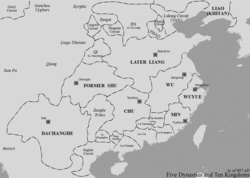Jin 晉 | |||||||||||||
|---|---|---|---|---|---|---|---|---|---|---|---|---|---|
| ?–923 | |||||||||||||
 | |||||||||||||
| Capital | Taiyuan | ||||||||||||
| Government | Principality | ||||||||||||
| Prince | |||||||||||||
• 896/907–908 | Li Keyong | ||||||||||||
• 908–923 | Li Cunxu | ||||||||||||
| Historical era | Five Dynasties and Ten Kingdoms period | ||||||||||||
• Li Keyong created the Prince of Jin | 896 | ||||||||||||
• Established | ? | ||||||||||||
• Disestablished | 923 | ||||||||||||
| Currency | Chinese coin, Chinese cash | ||||||||||||
| |||||||||||||
| Today part of | China | ||||||||||||
Jin (晉; 883 (or 896 or 907)–923), also known as Hedong (河東) and Former Jin (前晉) in Chinese historiography, was a dynastic state of China and the predecessor of the Later Tang dynasty. Its princely rulers were the ethnic Shatuo warlords Li Keyong and Li Cunxu (Li Keyong's son). Although the Five Dynasties period began only in 907, Li Keyong's territory which centered around modern Shanxi can be referred to as Jin as early as 896, when he was officially created the Prince of Jin by the failing and powerless Tang dynasty court, or even (by extension, anachronistically) as early as 883, when he was created the jiedushi military governor of Hedong Circuit, which controlled more or less the same territory.